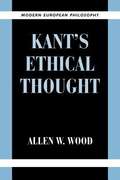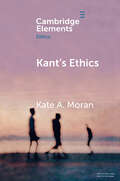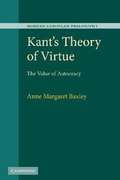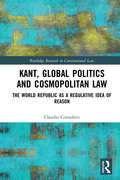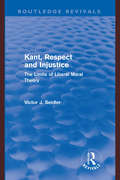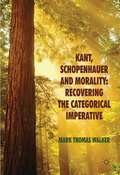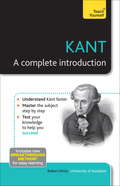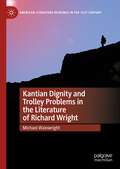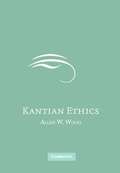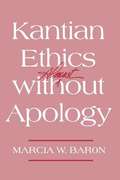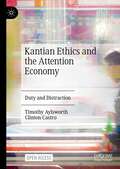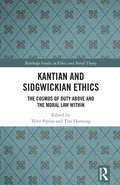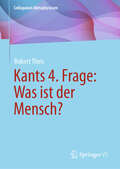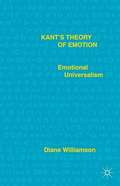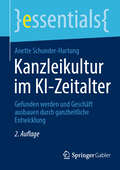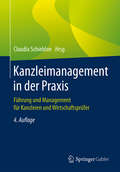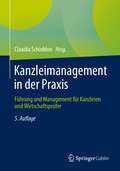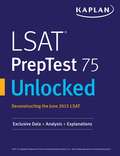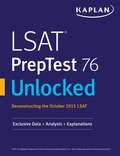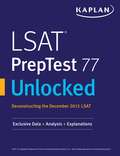- Table View
- List View
Kant's Defense of Common Moral Experience
by Jeanine GrenbergIn this book, Jeanine Grenberg argues that everything important about Kant's moral philosophy emerges from careful reflection upon the common human moral experience of the conflict between happiness and morality. Through careful readings of both the Groundwork and the Critique of Practical Reason, Grenberg shows that Kant, typically thought to be an overly technical moral philosopher, in fact is a vigorous defender of the common person's first-personal encounter with moral demands. Grenberg uncovers a notion of phenomenological experience in Kant's account of the fact of reason, develops a new a reading of the fact, and grants a moral epistemic role for feeling in grounding Kant's a priori morality. The book thus challenges readings which attribute only a motivational role to feeling; and Fichtean readings which violate Kant's commitments to the limits of reason. This study will be valuable to students and scholars engaged in Kant studies.
Kant's Ethical Thought (Modern European Philosophy Series)
by Allen W. Wood Robert B. PippinThis is a major new study of Kant's ethics that will transform the way students and scholars approach the subject in future. Allen Wood argues that Kant's ethical vision is grounded in the idea of the dignity of the rational nature of every human being. It focuses for the first time on the central role played in Kant's ethical theory by the value of rational nature as an end itself. In addition, it shows the importance of Kant's systematic theory of human nature and history, and its implications for the structure, formulation, and application of Kant's moral principles. This comprehensive study will be of critical importance to students of moral philosophy, the history of ideas, political theory, and religious studies.
Kant's Ethics (Elements in Ethics)
by Kate A. MoranThe Element provides an overview of Immanuel Kant's arguments regarding the content of the moral law (the categorical imperative), as well as an exposition of his arguments for the bindingness of the moral law for rational agents. The Element also considers common objections to Kant's ethics.
Kant's Groundwork of the Metaphysics of Morals
by Jens TimmermannThe Groundwork of the Metaphysics of Morals is Kant's central contribution to moral philosophy, and has inspired controversy ever since it was first published in 1785. Kant champions the insights of 'common human understanding' against what he sees as the dangerous perversions of ethical theory. Morality is revealed to be a matter of human autonomy: Kant locates the source of the 'categorical imperative' within each and every human will. However, he also portrays everyday morality in a way that many readers find difficult to accept. The Groundwork is a short book, but its argument is dense, intricate and at times treacherous. This commentary explains Kant's arguments paragraph by paragraph, and also contains an introduction, a synopsis of the argument, six short interpretative essays on key topics of the Groundwork, and a glossary of key terms. It will be an indispensable tool for anyone wishing to study the Groundwork in detail.
Kant's Lectures on Ethics
by Lara Denis Oliver SensenThis is the first book devoted to an examination of Kant's lectures on ethics, which provide a unique and revealing perspective on the development of his views. In fifteen newly commissioned essays, leading Kant scholars discuss four sets of student notes reflecting different periods of Kant's career: those taken by Herder (1762–4), Collins (mid-1770s), Mrongovius (1784–5) and Vigilantius (1793–4). The essays cover a diverse range of topics, from the relation between Kant's lectures and the Baumgarten textbooks, to obligation, virtue, love, the highest good, freedom, the categorical imperative, moral motivation and religion. Together they will provide the reader with a deeper and fuller understanding of the evolution of Kant's moral thought. The volume will be of interest to a range of readers in Kant studies, ethics, political philosophy, religious studies and the history of ideas.
Kant's Theory of Virtue
by Anne Margaret BaxleyAnne Margaret Baxley offers a systematic interpretation of Kant's theory of virtue, whose most distinctive features have not been properly understood. She explores the rich moral psychology in Kant's later and less widely read works on ethics, and argues that the key to understanding his account of virtue is the concept of autocracy, a form of moral self-government in which reason rules over sensibility. Although certain aspects of Kant's theory bear comparison to more familiar Aristotelian claims about virtue, Baxley contends that its most important aspects combine to produce something different - a distinctively modern, egalitarian conception of virtue which is an important and overlooked alternative to the more traditional Greek views which have dominated contemporary virtue ethics.
Kant, Global Politics and Cosmopolitan Law: The World Republic as a Regulative Idea of Reason (Routledge Research in Constitutional Law)
by Claudio CorradettiWhy is there so much attention on Kant's global politics in present day law and philosophy? This book highlights the potential fruitfulness of Kant's cosmopolitan thought for understanding the complexities of the contemporary political world. It adopts a double methodological strategy by reconstructing a genealogical conceptual journey showing the development of international law, as well as introducing an interpretation of cosmopolitanism centred on Kant's theory of a metaphysics of freedom. The result is a novel focus on Kant's notion of the world republic. The hypothesis here defended is that the world republic stands as a way of thinking about international politics where the possibility of progression towards peace results from its use as a regulative idea.
Kant, Respect and Injustice: The Limits of Liberal Moral Theory (Routledge Revivals)
by Victor SeidlerIn this work, originally published in 1986, Victor Seidler explores the different notions of respect, equality and dependency in Kant’s moral writings. He illuminates central tensions and contradictions not only within Kant’s moral philosophy, but within the thinking and feeling about human dignity and social inequality which we take very much for granted within a liberal moral culture. In challenging our assumption of the autonomy of morality, Seidler also questions our understanding of what it means for someone to live as a person in his or her own right. The autonomy of individuals cannot be assumed but has to be reasserted against relationships of subordination. This involves a break with a rationalist morality, so that respect for others involves respect for emotions, feelings, desires and needs, and establishes a fuller autonomy as a basis for freedom and justice.
Kant, Schopenhauer and Morality: Recovering the Categorical Imperative
by Mark Thomas WalkerWhy should I be moral? Why should I give any weight to the interests of others simply for what they are, and not for what I can get out of it? After all, we are all different persons aren't we? So your good is your good and my good is mine. Why should your good, just as such, be mine as well? Why should I love my neighbour as myself if s/he is not myself? Drawing upon the work of two great German philosophers, Immanuel Kant (1724-1804) and Arthur Schopenhauer (1788-1860) this book radically challenges the assumptions lying behind these questions. After reading it you may never think of how you relate to others in quite the same way again.
Kant: A Complete Introduction: Teach Yourself
by Robert WicksWritten by Robert Wicks, a recognised Kant specialist who teaches at the University of Auckland, Kant: A Complete Introduction is designed to give you everything you need to succeed, all in one place. It covers the key areas that students are expected to be confident in, outlining the basics in clear jargon-free English, and then providing added-value features like summaries of key books, and even lists of questions you might be asked in your seminar or exam.The book uses a structure that mirrors many university courses on Freud and psychoanalysis - explaining and contextualising Kant's theories, which have been among the most influential in Philosophy. The book starts by introducing Kant and his way of thinking and arguing, before looking at how Kant answered three key questions: What can I know? What should I do? What may I hope? In doing so, Professor Wicks introduces the reader to all of Kant's key work, including The Critique of Pure Reason.Teach Yourself titles employ the 'Breakthrough method', which is designed specifically to overcome problems that students face.- Problem: "I find it difficult to remember what I've read."; Solution: this book includes end-of-chapter questions and summaries, and flashcards of key points available on-line and as apps- Problem: "Most books mention important other sources, but I can never find them in time."; Solution: this book includes key texts and case studies are summarised, complete with fully referenced quotes ready to use in your essay or exam.- Problem: "Lots of introductory books turn out to cover totally different topics than my course."; Solution: this book is written by a current university lecturer who understands what students are expected to know.
Kantian Dignity and Trolley Problems in the Literature of Richard Wright (American Literature Readings in the 21st Century)
by Michael WainwrightThis book examines the literature of African-American author Richard Wright and the philosophy of Immanuel Kant, arguing that Wright was not only the foremost proponent of minoritarian protest literature, but also a groundbreaking minoritarian exponent of philosophical literature. In presenting this argument, the volume defends trolley problems from the criticism that some philosophers level against them by promoting their use as an interpretive tool for literary scholars. Starting with Martha C. Nussbaum’s interventions in literary theory concerning Henry James and perceptive equilibrium, this book draws on the philosophical thoughts of her contemporaries—Philippa Foot, John Rawls, Judith Jarvis Thomson, and Derek Parfit—to analyze Uncle Tom’s Children, especially “Down by the Riverside,” alongside other works by Wright. This approach emphasizes Wright’s recognition of the importance and integrity of Kant’s concept of dignity.
Kantian Ethics
by Allen W. WoodIn this book, Allen W. Wood investigates Kant's conception of ethical theory, using it to develop a viable approach to the rights and moral duties of human beings.
Kantian Ethics Almost Without Apology
by Marcia W. BaronA defence of Kant's deontological conception of ethics. The author offers reflections on two supposed problems with Kant's ethics: that it leaves no room for supererogatory actions and that it overemphasizes the value of acting from duty.
Kantian Ethics and the Attention Economy: Duty and Distraction
by Clinton Castro Timothy AylsworthIn this open access book, Timothy Aylsworth and Clinton Castro draw on the deep well of Kantian ethics to argue that we have moral duties, both to ourselves and to others, to protect our autonomy from the threat posed by the problematic use of technology. The problematic use of technologies like smartphones threatens our autonomy in a variety of ways, and critics have only begun to appreciate the vast scope of this problem. In the last decade, we have seen a flurry of books making “self-help” arguments about how we could live happier, more fulfilling lives if we were less addicted to our phones. But none of these authors see this issue as one involving a moral duty to protect our autonomy.
Kantian and Sidgwickian Ethics: The Cosmos of Duty Above and the Moral Law Within (Routledge Studies in Ethics and Moral Theory)
by Tim Henning Tyler PaytasImmanuel Kant and Henry Sidgwick are towering figures in the history of moral philosophy. Kant’s views on ethics continue to be discussed and studied in detail not only in philosophy, but also theology, political science, and legal theory. Meanwhile, Sidgwick is emerging as the philosopher within the utilitarian tradition who merits the same meticulous treatment that Kant receives. As champions of deontology and consequentialism respectively, Kant and Sidgwick disagree on many important issues. However, close examination reveals a surprising amount of consensus on various topics including moral psychology, moral epistemology, and moral theology. This book presents points of agreement and disagreement in the writings of these two giants of philosophical ethics. The chapters will stimulate discussions among moral theorists and historians of philosophy by applying cutting-edge scholarship on each philosopher to shed light on some of the more perplexing arguments and views of the other, and by uncovering and examining points of agreement between Sidgwick and Kant as possible grounds for greater convergence in contemporary moral philosophy. This is the first full-length volume to investigate Sidgwick and Kant side by side. It will be of major interest to researchers and advanced students working in moral philosophy and its history.
Kantianism for Animals: A Radical Kantian Animal Ethic (The Palgrave Macmillan Animal Ethics Series)
by Nico Dario MüllerThis open access book revises Kant’s ethical thought in one of its most notorious respects: its exclusion of animals from moral consideration. The book gives readers in animal ethics an accessible introduction to Kant’s views on our duties to others, and his view that we have only ‘indirect’ duties regarding animals. It then investigates how one would have to depart from Kant in order to recognise that animals matter morally for their own sake. Particular attention is paid to Kant’s ‘Formula of Humanity,' the role of autonomy and the moral law, as well as Kant’s notions of practical reason and animal instinct. The result is a deliberately amended version of Kantianism which nevertheless remains faithful to central aspects of Kant’s thought. The book’s final part illustrates the framework’s use in applied contexts, addressing the issues of using animals as mere means, the ethics of veganism and vegetarianism, and environmental protection. Nico Dario Müller shows how, when furnished with duties to animals, Kant's moral philosophy can be a powerful resource for animal ethicists.
Kants 4. Frage: Was ist der Mensch? (Colloquium Metaphysicum)
by Robert TheisIn seiner berühmten Logikvorlesung stellt Immanuel Kant die berühmten Leitfragen der Philosophie "Was kann ich wissen?", "Was soll ich tun?" und "Was darf ich hoffen?". Dem fügt er dann die Frage "Was ist der Mensch?" an und schreibt, all das, was in den ersten Fragen behandelt würde, könne man zur vierten zählen. Dieses Buch fragt demnach nach dem anthropologischen Subtext der drei ersten Fragen, also: Was erfahren wir über die vierte Frage, wenn Kant sich der Wissens-, Sollens- und Hoffensfrage zuwendet?
Kant’s Theory of Emotion
by Diane WilliamsonWilliamson explains, defends, and applies Kant's theory of emotion. Looking primarily to the Anthropology and the Metaphysics of Morals, she situates Kant's theory of affect within his theory of feeling and focuses on the importance of moral feelings and the moral evaluation of our emotions. Feelings, for Kant, are physiological occurrences (pains and/or pleasures) that are caused by the cognitive faculty, including perception and present experience. Their underlying thoughts must be morally evaluated. She illustrates both the role that emotions play in developing virtue and the role they can play in leading to vice and evil. Kant's theory has an advantage over current cultural and research trends because it neither suggests that we must blindly follow our feelings nor that emotions are irrational forces that must be overcome. Instead, Kant's theory does the best job of helping us to understand and evaluate our emotions.
Kanzleikultur im KI-Zeitalter: Gefunden werden und Geschäft ausbauen durch ganzheitliche Entwicklung (essentials)
by Anette Schunder-HartungWie können Sie sich als Kanzlei auch im KI-Zeitalter noch behaupten? Gute Kanzleien gibt es viele, guten Rat auch – um andere für die eigene Kanzlei zu gewinnen, bedarf es einer systematischen, ganzheitlichen Entwicklung. Nur so heben Sie sich im schriller werdenden Konzert aus 24/7 verfügbarer Software, zunehmend smarten In-house-Juristen und gar berufsfremder Konkurrenz hervor. In diesem essential erfahren Sie, wie Sie sich unverwechselbar machen und Schritt für Schritt ihre höchsteigene Kanzleikultur herausarbeiten – nach innen wie nach außen. Dazu geht Schunder-Hartung in einem strukturierten Verfahren den entscheidenden Fragen auf unterschiedlichen Ebenen nach.
Kanzleimanagement in der Praxis: Führung Und Management Für Kanzleien Und Wirtschaftsprüfer
by Claudia SchieblonDieses Buch bietet einen Überblick über die wichtigen Themen des Kanzleimanagements. Autoren sind Managing Partner national und international agierender Kanzleien unterschiedlicher Ausrichtung. Das Buch richtet sich an Anwälte, Wirtschaftsprüfer und Steuerberater aus kleinen wie großen Einheiten, Fachkräfte aus Management und Business-Teams der Kanzleien sowie an Berater, denen es eine Hilfestellung bei den besonderen Fragestellungen von Kanzleien bietet.Für die 4. Auflage wurde das Buch vollständig überarbeitet und um mehrere Kapitel ergänzt.
Kanzleimanagement in der Praxis: Führung und Management für Kanzleien und Wirtschaftsprüfer
by Claudia SchieblonVon Praktikern für Praktiker: Dieses Buch gibt einen Überblick über die aktuell wichtigen Themen des Kanzleimanagements. Die Autoren sind erfahrene Managing Partner, COOs und Leiter der Business Service-Einheiten von national wie international agierenden Wirtschaftskanzleien. Das Buch richtet sich an Anwälte, Wirtschaftsprüfer und Steuerberater aus kleinen wie großen Kanzleien sowie an Fachleute aus dem Kanzleimanagement und solche, die es werden wollen. Es soll ihnen eine Hilfestellung bei den besonderen Fragestellungen von Kanzleien bieten.Für die 5. Auflage wurde das Buch vollständig überarbeitet und um zahlreiche Themen ergänzt.
Kapazitätszurückhaltungen auf dem Stromgroßhandelsmarkt: Zwischen Wettbewerbsrecht und Regulierung
by Panagiotis TsangarisDieses Buch befasst sich mit der Frage der Kapazitätszurückhaltungen auf dem Stromgroßhandelsmarkt. Stromerzeuger können auf dem Großhandelsmarkt Marktmacht ausüben, indem sie entweder Erzeugungskapazitäten zurückhalten oder Preise über dem Wettbewerbsniveau festsetzen, um einen höheren Marktpreis zu erzielen und damit ihre Einnahmen zu steigern. Nach einer umfassenden Erläuterung der Praktiken der Kapazitätszurückhaltungen und der Probleme, die sich bei einem wettbewerbsrechtlichen Verfahren ergeben, wird in dem Buch analysiert, ob ein erhöhter Grad an Transparenz, wie er in der REMIT und der Verordnung 543/2013 vorgesehen ist, das effiziente Funktionieren der Stromgroßhandelsmärkte und die Untersuchung der Kapazitätszurückhaltungen erleichtern könnte. Außerdem wird untersucht, wie sich das Verbot der Marktmanipulation, wie es in der REMIT vorgesehen ist, auf den Umgang mit den missbräuchlichen Praktiken der Kapazitätszurückhaltungen auf dem Stromgroßhandelsmarkt auswirkt.
Kaplan Companion to LSAT PrepTest 75: Exclusive Data, Analysis & Explanations f
by KaplanTaking an official LSAC PrepTest is great practice for the LSAT, but reviewing a practice test afterward is where you really improve. Supercharge your LSAT prep with The Kaplan Companion to PrepTest 75. Complete explanations for every question and answer choiceSample Logic Games sketches and Reading Comprehension roadmapsThe Inside Story: Exclusive data on question difficulty and student performance8 Can't Miss Features of PrepTest 75PrepTest 75 In Context: Comparison of PrepTest 75 to recent LSAT trendsGlossary of LSAT terminologyEvery question and answer choice is discussed, along with detailed strategies for racking up points and exclusive data on student performance identifying the most difficult questions and how PrepTest 75 compares to recent LSAT trends. In addition, you'll see sample sketchwork for logic games and sample roadmaps for reading comprehension passages. If you are new to the LSAT, a glossary offers definitions for terminology that will help you to think like the testmaker. *PrepTest 75 not included. LSAT® is a registered trademark of the Law School Admission Council, which neither sponsors nor endorses this product.
Kaplan Companion to LSAT PrepTest 76: Exclusive Data, Analysis & Explanations fo
by KaplanTaking an official LSAC PrepTest is great practice for the LSAT, but reviewing a practice test afterward is where you really improve. Supercharge your LSAT prep with The Kaplan Companion for PrepTest 76. Complete explanations for every question and answer choiceSample Logic Games sketches and Reading Comprehension roadmapsThe Inside Story: Exclusive data on question difficulty and student performance8 Can't Miss Features of PrepTest 76PrepTest 76 In Context: Comparison of PrepTest 76 to recent LSAT trendsGlossary of LSAT terminologyEvery question and answer choice is discussed, along with detailed strategies for racking up points and exclusive data on student performance identifying the most difficult questions and how PrepTest 76 compares to recent LSAT trends. In addition, you'll see sample sketchwork for logic games and sample roadmaps for reading comprehension passages. If you are new to the LSAT, a glossary offers definitions for terminology that will help you to think like the testmaker. *PrepTest 76 not included. LSAT® is a registered trademark of the Law School Admission Council, which neither sponsors nor endorses this product.
Kaplan Companion to LSAT PrepTest 77: Exclusive Data, Analysis & Explanations fo
by KaplanTaking an official LSAC PrepTest is great practice for the LSAT, but reviewing a practice test afterward is where you really improve. Supercharge your LSAT prep with The Kaplan Companion to PrepTest 77. Complete explanations for every question and answer choiceSample Logic Games sketches and Reading Comprehension roadmapsThe Inside Story: Exclusive data on question difficulty and student performance8 Can't Miss Features of PrepTest 77PrepTest 77 In Context: Comparison of PrepTest 77 to recent LSAT trendsGlossary of LSAT terminologyEvery question and answer choice is discussed, along with detailed strategies for racking up points and exclusive data on student performance identifying the most difficult questions and how PrepTest 77 compares to recent LSAT trends. In addition, you'll see sample sketchwork for logic games and sample roadmaps for reading comprehension passages. If you are new to the LSAT, a glossary offers definitions for terminology that will help you to think like the testmaker. *PrepTest 77 not included. LSAT® is a registered trademark of the Law School Admission Council, which neither sponsors nor endorses this product.

